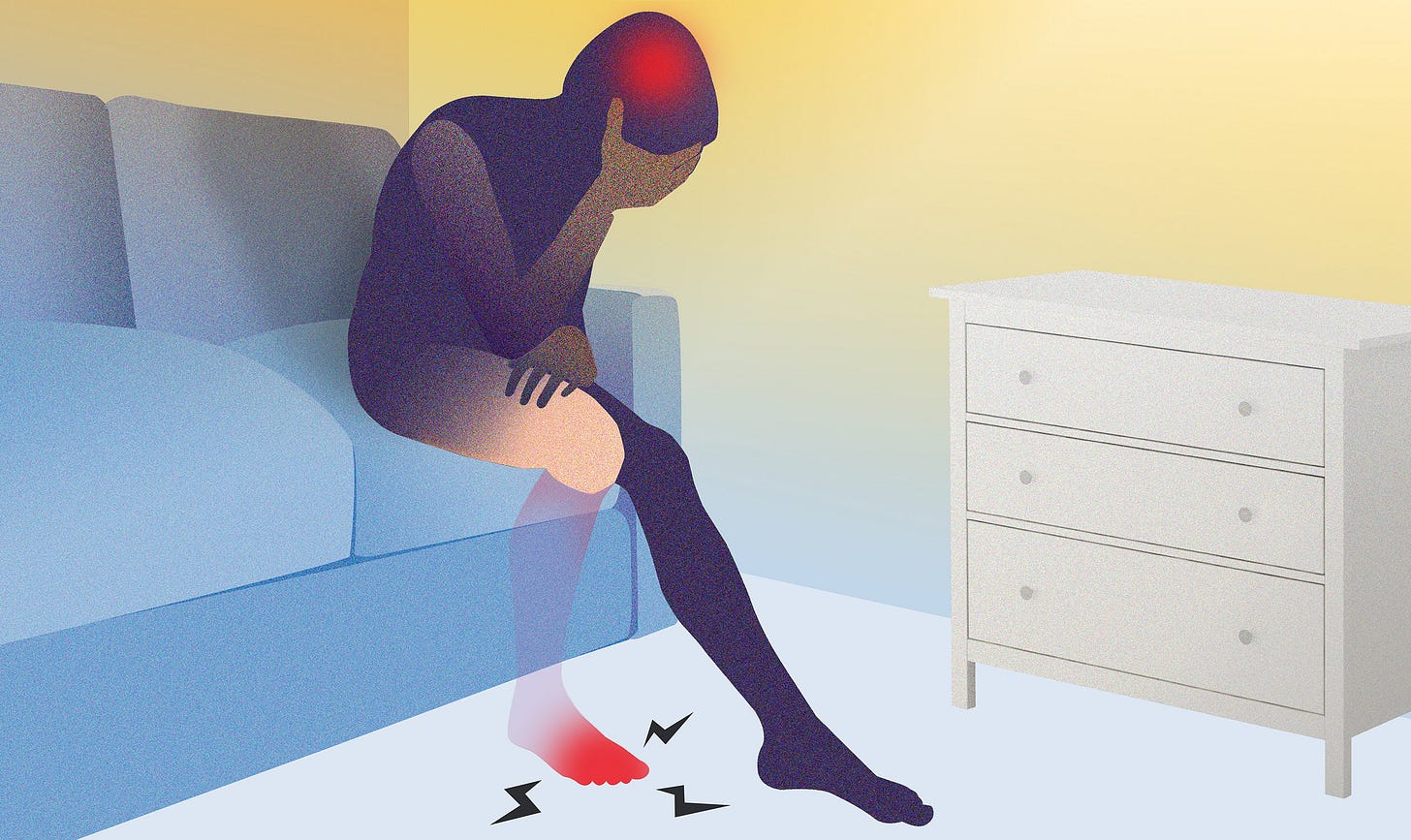
Phantom Limb pain therapies
My past newsletter reported on progress in treating phantom limb pain, Real advances in Rehab Medicine :
"I described mirror therapy for phantom limb pain in my book, Be the Rainbow * Bridge Heaven and Earth: How-to Manual for Integrating Alternative and Evidence-Based Medicine. It illustrates well, where the body sensation is perceived in the brain, irrespective of the peripheral neuronal inputs. And, that the brain can be ‘fooled’ into pretending the good limb is still intact, thus stopping aberrant neuronal firing misinterpreted as pain.”
Recently, another report describes an initial therapy to apply to amputation sites resulting from war wounds.
Introduction This exploratory study investigates the potential of perineuromal hydrodissection as an adjunct to opioid therapy for postamputation pain, specifically focusing on residual limb and phantom limb pain (PLP). Given the correlations between acute pain and the development of chronic pain, the primary aims were to estimate the effect size of early hydrodissection of scar tissue around residual limb neuroma(s) and to identify the best time frame for treatment. Methods 74 patients with war-related limb amputations and painful neuromas were included in this observational analysis. 38 Ukrainian patients with war-related limb amputation and a painful neuroma(s) who underwent hydrodissection and opioid therapy within 6 months of amputation were compared with 36 patients who received opioids alone. Co-primary outcome measures were median reduction from baseline in average residual limb and PLP at 12 weeks. The composite positive outcome was designated as a ≥2-point decrease or 30% reduction in average residual limb and PLP, satisfaction with treatment, and not requiring an increase in analgesics. Results Hydrodissection as an add-on to opioids resulted in a greater reduction in average residual limb pain at 12 weeks (−2.00±1.00 vs −1.00±1.00; p<0.001) and earlier time periods, but PLP only through 4 weeks. At 12 weeks, Hospital Anxiety and Depression Scale anxiety (10.00±2.00 vs 11.00±1.00; p<0.001) but not depression score was lower in the hydrodissection group. Opioid use in the hydrodissection group significantly declined from 41.32±9.63 to 33.42±8.78 morphine equivalents per day (p=0.001) over the study, but not in the opioid-only group (p=0.20). Differences in 12-week satisfaction rates were not significant. Conclusions This exploratory study suggests perineuromal hydrodissection may improve residual limb pain and to a lesser degree phantom limb pain, particularly when implemented early in the course of postamputation pain. The study provides preliminary effect size estimates and identifies acute pain as a potential characteristic of patients who may respond more favorably to this intervention. - D Dmytriiev, et al.
CBD for pain
My past newsletter, Cannabis components: teasing apart effects on memory, sleep, analgesia, described the research into using cannabis as a analgesic.
Now a review article compares the use of medicinal cannabis for pain to the standard opioid therapy.
Reviews of the effectiveness of medicinal cannabis for chronic pain vary in their conclusions. IASP has identified that a key missing evidence in this debate is data from observational cohort studies, analyzed with comparative effectiveness methods. In a medically supervised context to the use of marijuana for chronic pain, we identified 440 patients certified for medical marijuana by pain specialists in a single healthcare system. They were characterized by a battery of patient-reported outcomes stored electronically in the University of Pittsburgh Patient Outcomes Repository for Treatment (PORT). At 3 months, 38.6% were responders, based on clinically meaningful improvements in pain, function, or global impression of change, and maintained this response at 6 months. In the 157 patients who were coprescribed opioids, at 6 months there was a mean 39.3% decrease in morphine milligram equivalents (P < 0.05 for the difference vs baseline). In addition, 8114 patients treated in the same pain clinics with prescription pain medications instead (nonopioid or opioid) during the same timeframe were selected from PORT as a control group for comparison. They had a 34.9% rate of response at 3 months. Using the causal inference method of stratified modeling, logistic regression revealed an odds ratio of 2.6 in favor of medical marijuana vs medication treatment (P < 0.01). Potential harms data were not available in the PORT registry. Medical marijuana was comparatively more effective than prescription medications for the treatment of chronic pain at 3 months, although the populations compared were slightly different. - AD Wasan, et al.
Ion Channels Involved
The mechanisms of action for pain relief were explored in recent reports.
Sodium channel in Dorsal Root Ganglion
My past newsletter describes the sodium channel in sensory neurons, Sensory sodium channels: target of new compounds for pain.
The nonpsychotomimetic cannabinoids were tested for their ability to alter this channel:
Targeting voltage-gated sodium (Nav) channels in sensory neurons, particularly Nav1.8, represents a promising therapeutic approach. Our work demonstrates that nonpsychotomimetic cannabinoids, including cannabidiol (CBD), cannabigerol (CBG), and cannabinol (CBN), effectively inhibit Nav1.8. …
The search for safe and nonaddictive pain treatments has led to a focus on key mediators of nociceptor excitability. Voltage-gated sodium (Nav) channels in the peripheral nervous system—Nav1.7, Nav1.8, and Nav1.9—play crucial roles in pain signaling. Among these, Nav1.8 has shown promise due to its rapid recovery from inactivation and role in repetitive firing, with recent clinical studies providing proof-of-principal that block of Nav1.8 can reduce pain in humans. We report here that three nonpsychotomimetic cannabinoids—cannabidiol (CBD), cannabigerol (CBG), and cannabinol (CBN)—effectively inhibit Nav1.8, suggesting their potential as analgesic compounds. In particular, CBG shows significant promise due to its ability to effectively inhibit excitability of peripheral sensory neurons. --M-R Ghovanloo, et al.
Potassium channel in Dorsal Root Ganglion
The sodium channel is not the only target for chronic pain therapy. New research examined the potassium channel and its modulation to adapt to painful imputs.
The action potential (AP) waveform of neurons from diverse organisms can undergo activity-dependent changes, which may impact plastic processes that depend on AP duration, such as synaptic transmission. To elucidate a molecular mechanism responsible for the modulation of use-dependent AP broadening, the authors show that this process is dynamically modulated by multisite phosphorylation of the inactivation domain in Kv3.4 potassium channels, which inhibits Kv3.4 cumulative inactivation. This mechanism of AP plasticity in dorsal root ganglion neurons may play a significant role in the peripheral modulation of pain….
Use-dependent spike broadening (UDSB) results from inactivation of the voltage-gated K+ (Kv) channels that regulate the repolarization of the action potential. However, the specific signaling and molecular processes that modulate UDSB have remained elusive. Here, we applied an adeno-associated viral vector approach and dynamic clamping to conclusively demonstrate how multisite phosphorylation of the N-terminal inactivation domain (NTID) of the Kv3.4 channel modulates UDSB in rat dorsal root ganglion (DRG) neurons. The Kv3.4 phosphonull variant promotes slow recovery from inactivation, cumulative inactivation, and UDSB. In contrast, the Kv3.4 phosphomimic variant promotes fast recovery from inactivation and robust resistance to cumulative inactivation and UDSB. Furthermore, knocking down Kv3.4 maximizes AP width and eliminates UDSB modulation. Together with the evidence from previous work, the results concretely suggest how dynamic UDSB modulation governed by multisite phosphorylation of the NTID of Kv3.4 in DRG neurons may play a significant role in mechanosensory transduction and pain modulation. - TD Alexander, et al.
More on Music as analgesic
My past newsletter, Music is Magic. Potent medicine for both body and mind reported that listening to soothing words and music during surgery appears to reduce pain levels and the need for pain relieving drugs after surgery.
Now a recent report relates that music provides pain relief when it is played at our own natural rhythms. It may be possible to reduce a patient's level of pain by taking a piece of music that they like and then adjust the tempo [the rate at which a passage is produced] to match their own internal rhythm. Known as our ‘spontaneous production rate’, it may be tied to our circadian rhythms.
Researchers compared the pain ratings of 60 participants as they were subjected to low levels of pain, either in silence or while listening to music that had been manipulated so that its tempo either matched the one that was most natural to each person or was slightly faster or slower. Compared to silence, music of whatever kind and at whatever tempo reduced participants' perceptions of pain. And the greatest reductions in pain levels were achieved when music was played at the rate matching the participant's own preferred tempo.
REFERENCES
D Dmytriiev, et al. Perineuromal hydrodissection for acute postamputation pain? An observational study in a time of war. Regional Anesthesia & Pain Medicine (2025). DOI: 10.1136/rDmytro Dmytriievapm-2024-106307
AD Wasan, et al. The comparative effectiveness of medicinal cannabis for chronic pain versus prescription medication treatment. PAIN. ():10.1097/j.pain.0000000000003506, May 13, 2022.
M-R Ghovanloo, et al. Nav1.8, an analgesic target for nonpsychotomimetic phytocannabinoids. Proceedings of the National Academy of Sciences (2025). DOI: 10.1073/pnas.2416886122
TD Alexander, et al. Molecular mechanism governing the plasticity of use-dependent spike broadening in dorsal root ganglion neurons. Proceedings of the National Academy of Sciences (2024). DOI: 10.1073/pnas.2411033121
W Yi, et al. Individualizing musical tempo to spontaneous rates maximizes music-induced hypoalgesia, Pain (2025). DOI: 10.1097/j.pain.0000000000003513





designed a cannabinoid molecule with a positive charge, preventing it from crossing the blood-brain barrier into the brain while allowing the molecule to engage CB1 receptors elsewhere in the body.
By modifying the molecule such that it only binds to pain-sensing nerve cells outside of the brain, the researchers achieved pain relief without mind-altering side effects.
Susruta Majumdar, A cryptic pocket in CB1 drives peripheral and functional selectivity, Nature (2025). DOI: 10.1038/s41586-025-08618-7. www.nature.com/articles/s41586-025-08618-7